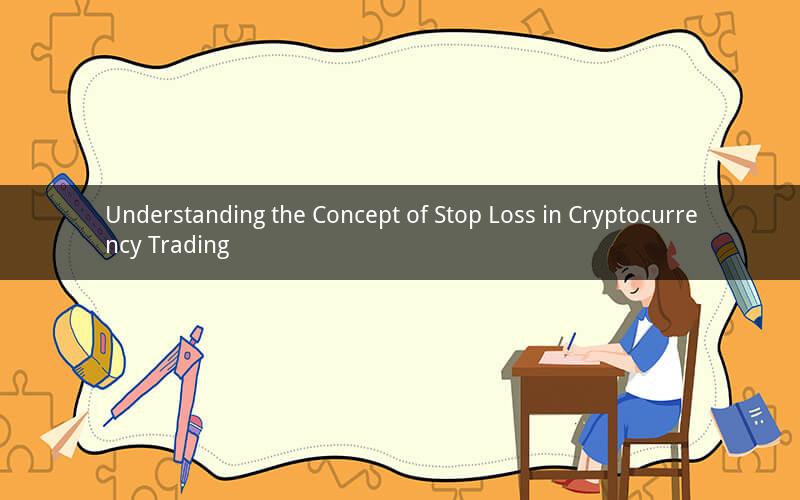
Introduction:
Cryptocurrency trading has gained immense popularity in recent years. As more investors enter the market, it is crucial to understand the various strategies and tools available to manage risks effectively. One such tool is the stop loss order, which plays a vital role in protecting investors' capital. This article aims to delve into the concept of stop loss in cryptocurrency trading, its importance, and how it can be utilized to minimize potential losses.
What is a Stop Loss in Cryptocurrency Trading?
A stop loss is an order placed by a trader to sell a cryptocurrency position when its price reaches a predetermined level. The primary purpose of a stop loss is to limit potential losses by automatically closing the position when the market moves against the trader's expectations. By setting a stop loss, traders can avoid emotional decision-making and the risk of holding onto losing positions for too long.
How Does a Stop Loss Work?
When a trader places a stop loss order, they specify a price level at which the order will be triggered. Once the market price reaches that level, the stop loss order becomes a market order, and the position is closed at the best available price. It is important to note that the actual price at which the trade is executed may differ slightly from the stop loss price due to market volatility and liquidity.
Importance of Stop Loss in Cryptocurrency Trading
1. Risk Management:
One of the key benefits of using a stop loss is risk management. By setting a predetermined level at which a trade will be closed, traders can limit their potential losses and protect their capital. This is especially crucial in the highly volatile cryptocurrency market, where prices can fluctuate rapidly.
2. Emotional Control:
Cryptocurrency trading can be emotionally taxing, especially during periods of market volatility. Stop loss orders help traders maintain emotional control by automating the exit strategy. Instead of holding onto losing positions due to fear or hope, traders can allow the market to dictate the outcome.
3. Protecting Profits:
In addition to limiting losses, stop loss orders can also be used to protect profits. Traders can set a take profit order alongside their stop loss, ensuring that they capture a certain percentage of gains while still allowing the trade to run further if the market moves in their favor.
Types of Stop Loss Orders
1. Stop Loss Order:
This is the most common type of stop loss order. It becomes a market order when the specified price level is reached, and the position is closed at the best available price.
2. Trailing Stop Loss Order:
A trailing stop loss order is similar to a regular stop loss, but it moves with the market price. As the cryptocurrency's price increases, the stop loss level also increases, allowing traders to lock in profits while still giving the trade room to grow. Conversely, if the price decreases, the stop loss level remains the same, protecting the initial investment.
3. Stop Loss Limit Order:
A stop loss limit order is a combination of a stop loss and a limit order. It becomes a limit order when the specified price level is reached, allowing traders to control the exact price at which they want to exit the trade.
Best Practices for Using Stop Loss Orders
1. Set Realistic Stop Loss Levels:
It is essential to set stop loss levels based on technical analysis and market conditions. Avoid setting stop loss levels too close to the current market price, as this may result in frequent triggering and increased slippage.
2. Adjust Stop Loss Levels as Needed:
Market conditions can change rapidly, so it is important to review and adjust stop loss levels periodically. This ensures that the stop loss remains effective and aligned with the trader's risk tolerance and market outlook.
3. Use Stop Loss Orders Consistently:
Consistency is key when using stop loss orders. Applying them to all trades helps maintain discipline and ensures that risk management strategies are consistently applied.
4. Combine Stop Loss with Take Profit Orders:
Using a take profit order alongside a stop loss order allows traders to protect gains while still giving the trade room to grow. This strategy can help maximize returns while minimizing potential losses.
5. Avoid Emotional Decision-Making:
Stop loss orders are designed to help traders avoid emotional decision-making. Stick to your strategy and avoid changing stop loss levels based on short-term market movements.
Frequently Asked Questions (FAQs)
1. What is the difference between a stop loss and a take profit order?
A stop loss order is used to limit potential losses by automatically closing a position when the price reaches a predetermined level. A take profit order, on the other hand, is used to secure gains by automatically closing a position when the price reaches a specified level.
2. Can a stop loss order be canceled?
Yes, a stop loss order can be canceled at any time before it is triggered. However, it is important to note that once the market price reaches the stop loss level, the order becomes a market order and cannot be canceled.
3. How does a stop loss affect the trading fees?
Stop loss orders do not directly affect trading fees. However, the cost of executing the market order when the stop loss is triggered can contribute to the overall trading fees.
4. Can a stop loss cause slippage?
Yes, a stop loss order can potentially cause slippage, especially in highly volatile markets. Slippage occurs when the market price moves quickly, and the trade is executed at a different price than the stop loss level.
5. Should I use a stop loss for every trade?
While using a stop loss is a good practice, it is not necessary for every trade. Traders should assess the risk and potential reward of each trade and decide whether a stop loss is appropriate based on their risk tolerance and trading strategy.